Are you curious about the best telescope to see Jupiter in 2024?
Jupiter, with its magnificent bands and moons, offers a celestial spectacle like no other. Selecting the right telescope to view this giant planet is not just about buying a tool; it’s about choosing a window to the wonders of our universe.
Well, we’ll be going over:
- What makes a telescope ideal for viewing Jupiter’s intricate details?
- How do different types of telescopes – refractors, reflectors, and compounds – affect your view of Jupiter?
- What are the must-have features in a telescope for both beginners and advanced stargazers aiming to observe Jupiter in 2024?
Armed with this guide, you’ll be able to select a telescope that not only suits your stargazing level but also brings Jupiter’s grandeur right to your backyard.
Let’s dive in.
Top Telescopes for Viewing Jupiter
- ABOTEC 90mm Refractor Telescope – Top Pick
- Celestron PowerSeeker 127EQ
- HSL 70mm Travel Telescope
- Celestron 70mm Travel Scope
- Free Soldier Telescope
Jupiter, the largest planet in our solar system, has always been a fascinating subject for sky gazers and the curious alike. With its distinctive stripes and a family of orbiting moons, it offers a spectacular view. I’ve tested and analyzed a range of telescopes to ensure you get impressive clarity and detail when observing this gas giant. Whether you’re a seasoned astronomer or a budding enthusiast, the telescopes on my list are sure to enhance your stargazing experience and bring the wonders of Jupiter right to your backyard.
ABOTEC 90mm Refractor Telescope
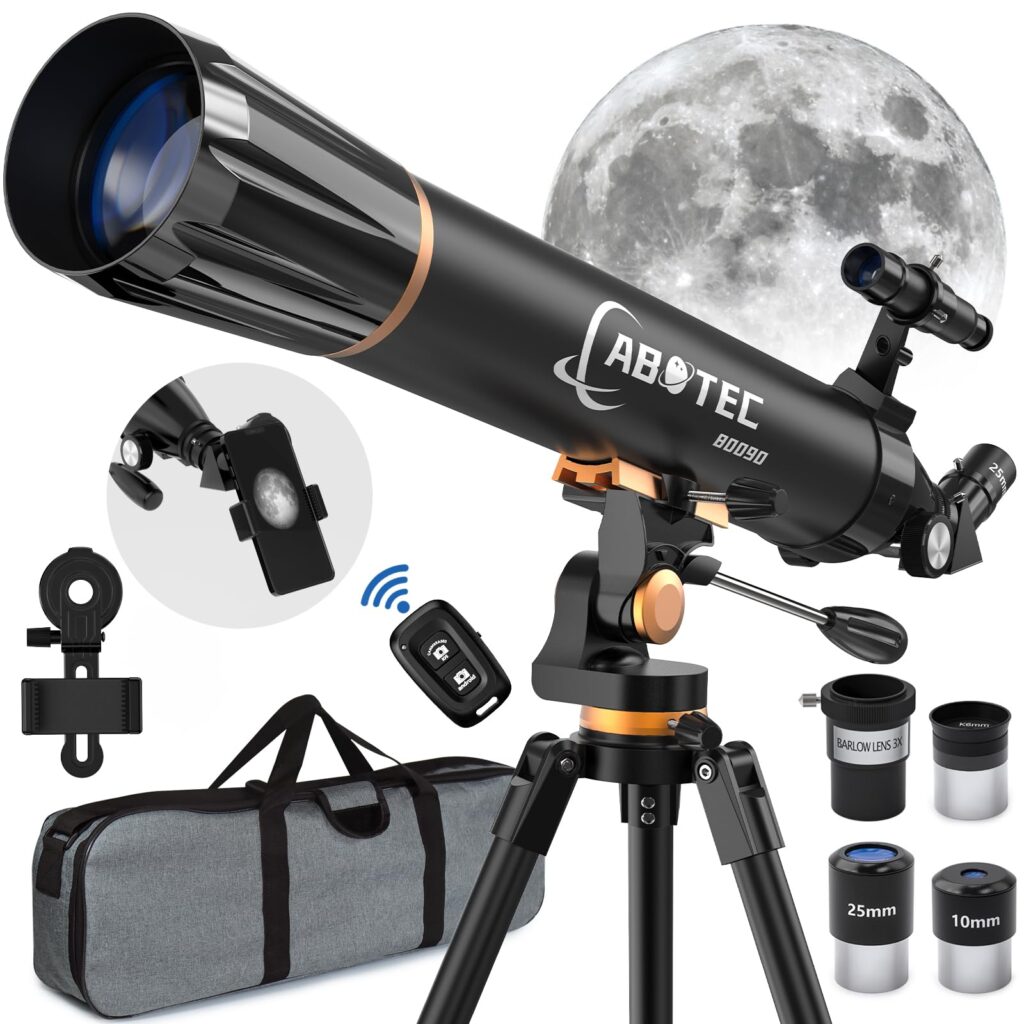
After spending some quality time stargazing with the ABOTEC 90mm Refractor Telescope, I can confidently say it’s a solid choice for budding astronomers eager to witness the grandeur of Jupiter and beyond.
Pros
Cons
Experiencing the ABOTEC telescope firsthand, the vibrant images of Jupiter’s bands and moons were a true delight. The telescope’s 90mm aperture works wonders for night-sky observations, drawing in abundant light to make celestial objects pop against the darkness. Crisp, well-defined views were the norm throughout my use, undoubtedly a testament to the quality of the coated lens.
The ease of setup was a breath of fresh air. Assembling the telescope straight from the box was a no-fuss affair, and I could get it up and ready for some stargazing action in mere minutes. I appreciate how this model is considerate of beginners, ensuring a smooth introduction to the world of astronomy without overwhelming them with complexity.
Balancing the telescope upon its sturdy tripod, I found it provided ample support at various angles. Whether I was scanning the horizon or tilting upwards to the zenith, the tripod held its own quite well. That said, during moments of high magnification, I had to be particularly mindful of my movements to maintain image stability.
A minor niggle came with the stock eyepieces, which are just fine for someone just starting out but might fall short for a seasoned hobbyist seeking more precision. Also, the finder scope demanded a bit of patience for accurate alignment, but once set, it did make pinpointing objects significantly more manageable.
In summary, the ABOTEC 90mm Refractor Telescope struck me as a reliable companion for anyone looking to admire the night sky’s wonders, including the majestic Jupiter, without getting tangled in the intricacies that come with more complex telescopic equipment.
Celestron PowerSeeker 127EQ
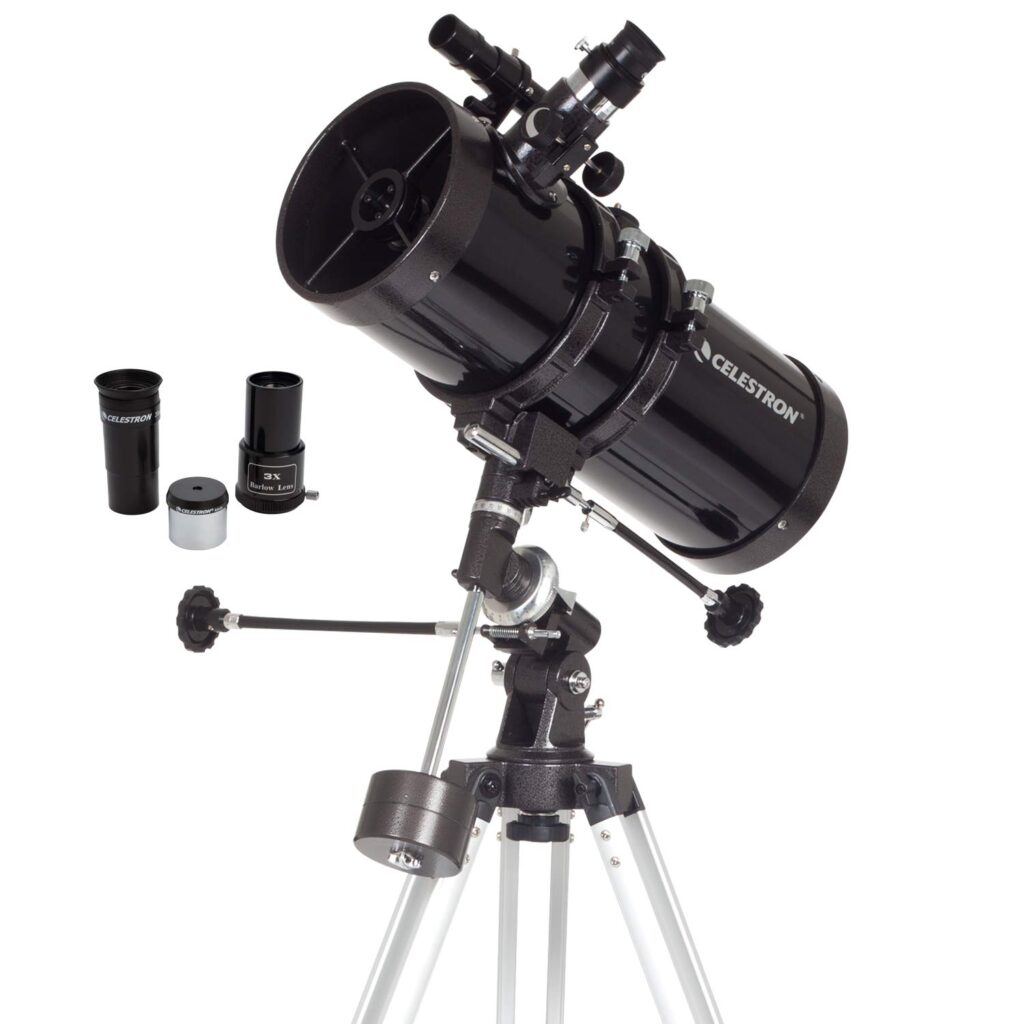
If you’re eyeing Jupiter’s bands or its moons, the Celestron PowerSeeker is a trusty companion for those clear, starry nights.
Pros
Cons
I recently spent an evening with the Celestron PowerSeeker 127EQ; the clarity of Jupiter’s stripes and moons was nothing short of remarkable. For anyone beginning their journey into astronomy, this telescope’s features facilitate a fascinating exploration of the celestial realm. The control knobs are quite intuitive, allowing for smooth tracking as our planet spins.
One particular aspect I appreciate is the portability. Despite its powerful capabilities, I find it quite straightforward to pack it up for a night in the wild, away from the city lights. It’s wonderful being able to take this telescope along on family trips, offering a shared experience of amazement and discovery.
However, patience is essential, especially when aligning the telescope for the first time. But, once you’ve mastered the setup process, the celestial pay-off is worth every minute spent. The provided Starry Night Software is also a stellar companion; the maps and sky object database expand your knowledge and enhance the overall stargazing experience.
Taking everything into account, the Celestron PowerSeeker provides a rewarding astronomical adventure, particularly when gazing upon the stunning details of Jupiter and its surroundings.
HSL 70mm Travel Telescope
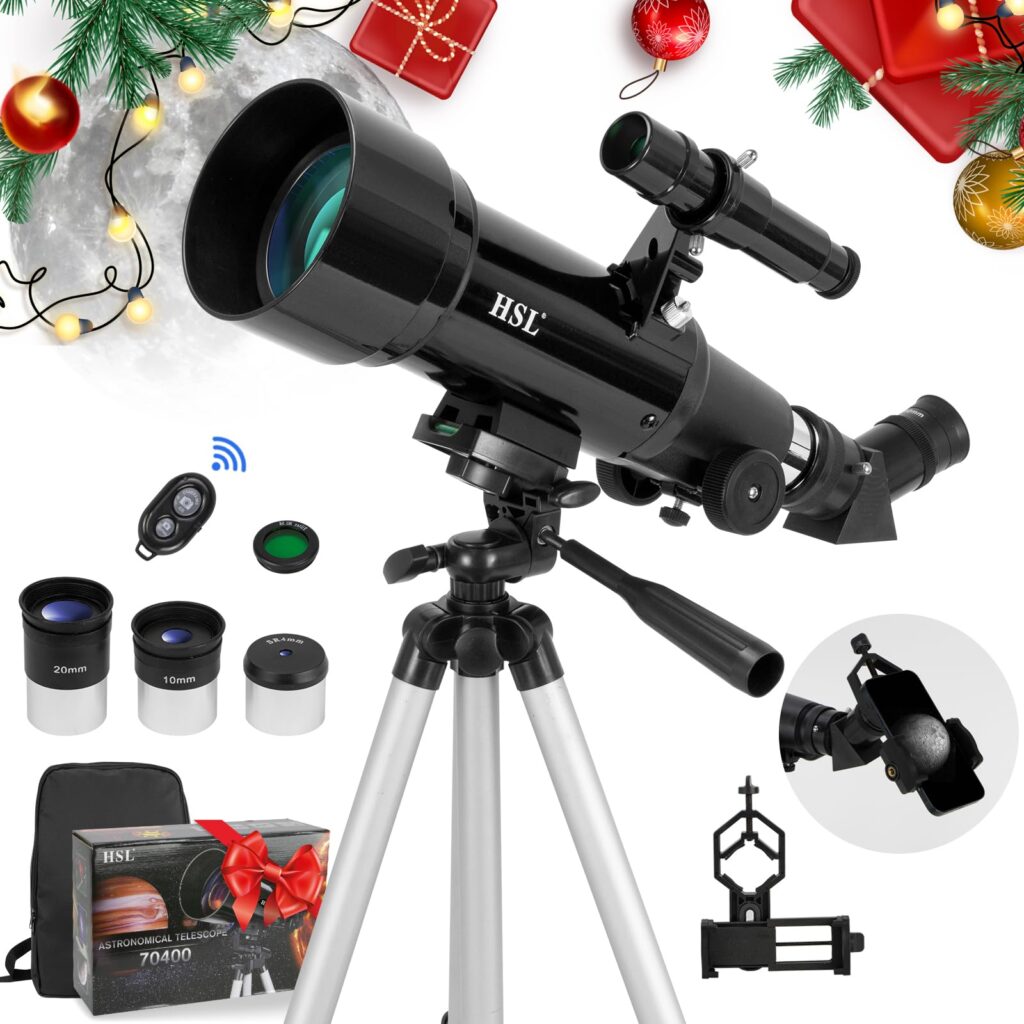
I was impressed by how the HSL telescope enhances my stargazing experiences, offering bright, expansive views of Jupiter’s stripes and moons.
Pros
Cons
Jupiter captivated my imagination the first time I saw it through this telescope. The sharpness of its bands and the dance of its moons were crisply displayed against the night sky. The high-definition optics did not disappoint, revealing details of the gas giant that left me in awe.
Traveling with this telescope proved effortless. I tossed it into its custom backpack and set off for dark skies with ease. Setup at a remote campsite was quick, which meant more time spent gazing upward.
The joy of snapping photos of Jupiter’s grandeur was unexpected. Attaching my smartphone, I shared snapshots with friends who were equally amazed. Admittedly, the wobble of the tripod tested my patience at times, especially when breezes came through, but the views made it worthwhile.
Overall, the HSL 70mm Telescope is a worthy pick for anyone eager to study Jupiter’s mysteries up close.
Celestron 70mm Travel Scope
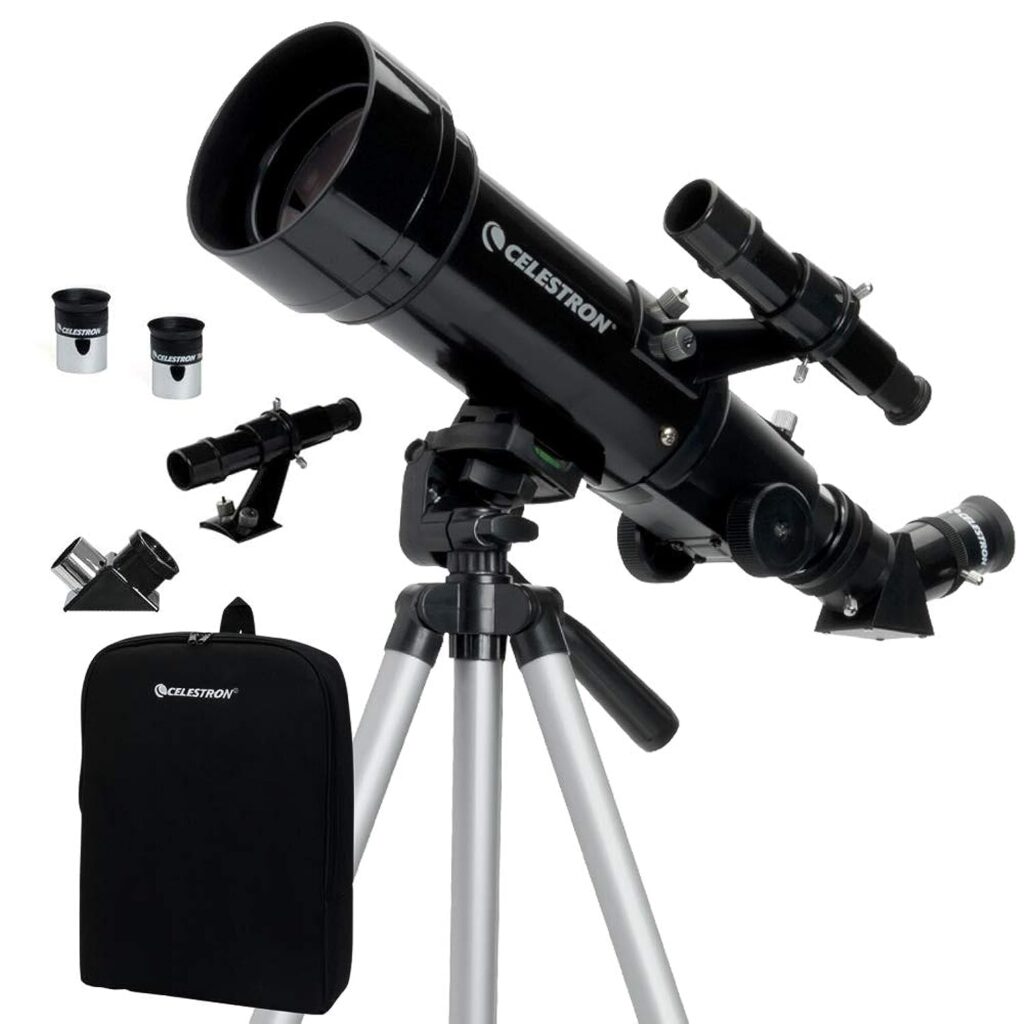
If you’re keen on stargazing and looking for Jupiter in the night sky, this Travel Scope might just be your perfect companion.
Pros
Cons
I’ve recently spent some time observing the skies with the Celestron 70mm Travel Scope and I must say, it’s been quite enjoyable. Its portability is unmatched – I could easily take it on a hike to escape the city lights. The optics brought the stars into sharp relief against the backdrop of the night sky. When Jupiter was visible, the gas giant appeared brilliantly through the eyepiece with its bands subtly on display, and I could even discern some of its moons.
However, while the Travel Scope is a joy to transport and set up, the lightweight tripod did present some challenges when I tried to stabilize my view under windy conditions. As I honed in on celestial wonders, a few vibrations would occasionally creep in, nudging me out of the perfect line of sight.
For those just starting out, or if you’re like me and prefer a telescope that’s as ready for adventure as you are, this Celestron model proves to be a great choice. Its ease of use made it simple to learn the ropes; the high-quality eyepieces offered satisfying views of Jupiter and its moons, which was truly exciting for a beginner astronomer.
That being said, if you find yourself in an urban setting rife with light pollution, be aware that it may take a bit more patience and practise to get the clear view you desire. While the scope performs admirably under dark skies, the city’s glow might make your hunt for Jupiter more challenging.
In conclusion, after having a hands-on experience with the Celestron 70mm Travel Scope, I can confidently recommend it to fellow stargazers. Its travel-friendliness and quality optics are a great match for anyone eager to get a closer look at Jupiter and other celestial sights. Just remember, to get the most out of your observing sessions, consider pairing it with a sturdier tripod, especially if you’re planning to venture out on breezy nights.
Free Soldier Telescope
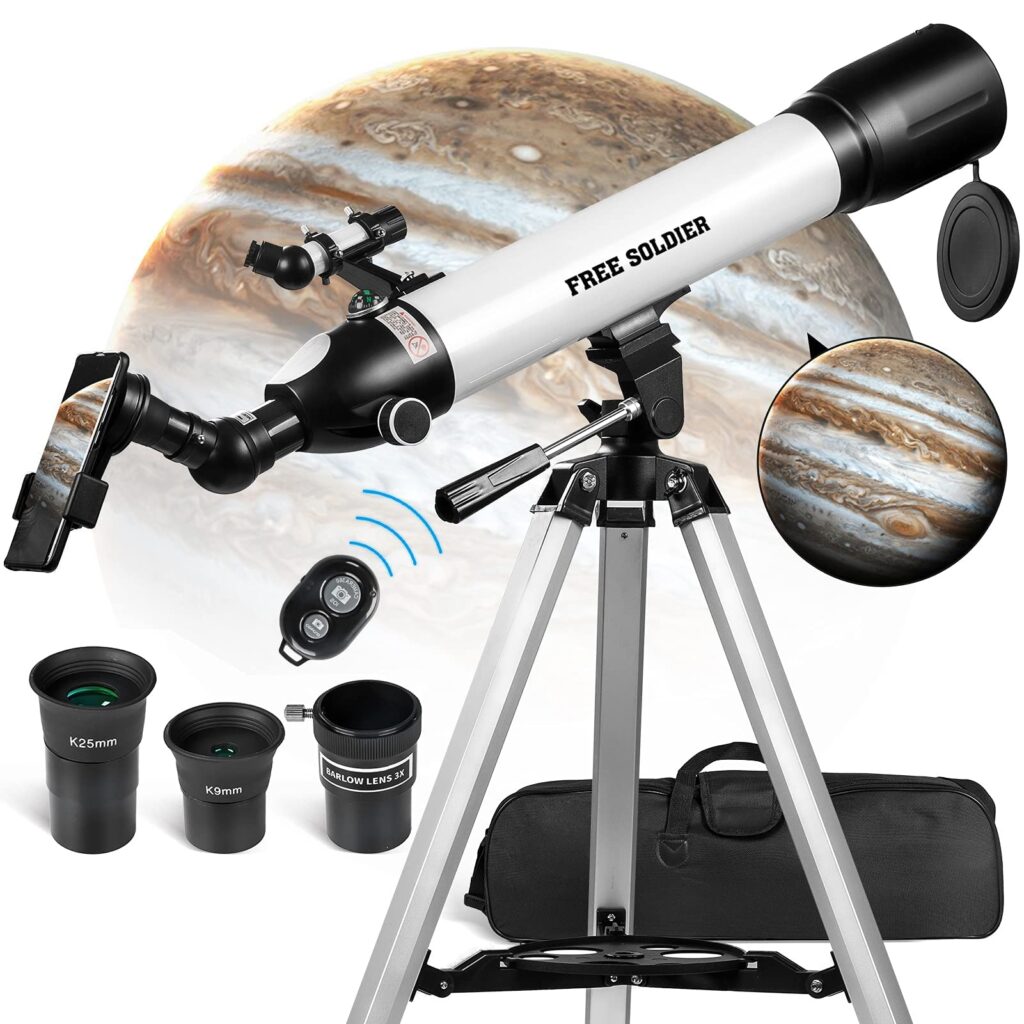
I’d recommend this telescope for anyone eager to start their journey into astronomy with a focus on planet watching, especially Jupiter.
Pros
Cons
Having had the pleasurable opportunity to gaze at the night sky through the Free Soldier telescope, its powerful magnification was immediately evident. Jupiter, with its swirling storms and moons, was a sight to behold, a remarkable testament to this telescope’s capabilities.
During my observation sessions, the crisp, bright images stood out. Even under less-than-ideal light conditions, the telescope managed to provide clear, detailed views. This is no doubt thanks to the multi-coated lens which optimizes light transmission.
While the setup was intuitive, and I got everything ready relatively quickly, it required some finesse to align and focus on celestial objects. A touch of persistence here pays off in stunning views. The addition of the phone adapter made capturing and sharing these cosmic wonders a breeze, adding to the overall experience.
Buying Guide
When I’m choosing a telescope to observe Jupiter, there are several key features I focus on to ensure I get the best viewing experience.
Aperture Size
The aperture is the diameter of the telescope’s main optical component and is the most important factor. A larger aperture means more light can enter, making distant objects like Jupiter appear brighter and more detailed. I recommend considering telescopes with a larger aperture.
Type of Telescope
There are three main types of telescopes: refractors, reflectors, and catadioptric. Each has advantages and differences in how they handle light.
- Refractors: Offer high contrast images and are low maintenance.
- Reflectors: Affordable and have a large aperture for their price.
- Catadioptric: Compact and portable with a good aperture size.
Magnification
While it might seem that higher magnification is better, it’s the telescope’s ability to gather light that truly enhances the view. I pay attention to the maximum useful magnification, which is typically 50-60 times the aperture in inches.
Mount Type
Equatorial mounts can follow the rotation of the sky and are excellent for tracking celestial objects, while Altazimuth mounts are more straightforward and easier to set up.
Accessories
I consider the quality of the included eyepiece and look for scopes that offer a sturdy tripod and finderscope, as they help in locating Jupiter quickly.
Portability
If I plan to travel with my telescope, I look for a model that strikes a balance between portability and good optical performance.
Here’s a simple table summarizing the key features I look at:
| Feature | Description |
|---|---|
| Aperture Size | Larger is better for detail and brightness. |
| Telescope Type | Refractors for contrast, Reflectors for budget, Catadioptric for portability. |
| Magnification | Maximum useful magnification is aperture x 50-60. |
| Mount Type | Equatorial for tracking, Altazimuth for ease of use. |
| Accessories | High-quality eyepieces and stable tripods enhance the experience. |
| Portability | Consider overall weight and size for travel. |
With these points in mind, I’m equipped with the knowledge to select a telescope that will provide the best views of Jupiter’s storms, belts, and moons.
Frequently Asked Questions
When it comes to observing Jupiter, selecting the right telescope is key. I’ll cover some of the top questions to help you get started on your celestial journey.
What are some recommended telescopes for beginners interested in observing Jupiter?
I recommend the Celestron AstroMaster 130EQ for beginners. Its 130mm aperture and user-friendly design provide great views of Jupiter’s bands and moons. Another great option is the Orion SkyQuest XT6, which offers a 150mm aperture that gives a clear image of Jupiter at a reasonable price.
Which telescope features are crucial for viewing detailed planetary images?
For detailed planetary images, the most crucial features include a high aperture (at least 4 inches or 100mm), a stable mount, good-quality eyepieces and a high focal ratio (f/8 or higher). Opt for a telescope with coated optics to enhance image brightness and clarity.
Can entry-level telescopes provide clear views of Saturn’s rings and Jupiter?
Yes, entry-level telescopes with an aperture of at least 70mm can provide clear views of Saturn’s rings and Jupiter. The Gskyer Astronomical Refracting Telescope and the Meade Instruments Infinity 102AZ are both capable of revealing these planetary details to beginners.
What are the best budget-friendly telescopes capable of planetary observation?
The Orion StarBlast 4.5 Astro Reflector Telescope is a budget-friendly option that does not compromise on quality for planetary observation. Another viable choice is the Celestron PowerSeeker 70EQ, which offers good optics for its price and the ability to resolve Jupiter’s main cloud bands.
How does a telescope’s aperture size affect its ability to view planets and galaxies?
A telescope’s aperture size determines its light-gathering capacity. Larger apertures allow more light to enter, which results in brighter, more detailed views of planets and galaxies. An aperture of 8 to 10 inches is ideal for serious planetary and galactic observations.
What additional equipment should one consider when purchasing a telescope for astrophotography?
For astrophotography, consider a motorized mount for tracking celestial bodies, a high-quality camera adapter, and a Barlow lens to increase magnification. Also, consider investing in a telescope with a GoTo system for easier navigation and tracking.


![Best Astronomy Podcasts: [year]’s List for Stargazers](https://observationhobbies.com/wp-content/uploads/2024/01/Best-Astronomy-Podcasts-768x525.png)
![Best Star Viewing in the World: Top [year] Spots](https://observationhobbies.com/wp-content/uploads/2024/01/image-367-768x525.jpeg)

![Best Telescope for Deep Space Observation: Top [year] Picks](https://observationhobbies.com/wp-content/uploads/2024/01/Best-Telescope-for-Deep-Space-Observation-768x525.png)

![Best Monoculars for Stargazing: Top [year] Picks](https://observationhobbies.com/wp-content/uploads/2024/01/Monoculars-768x525.png)